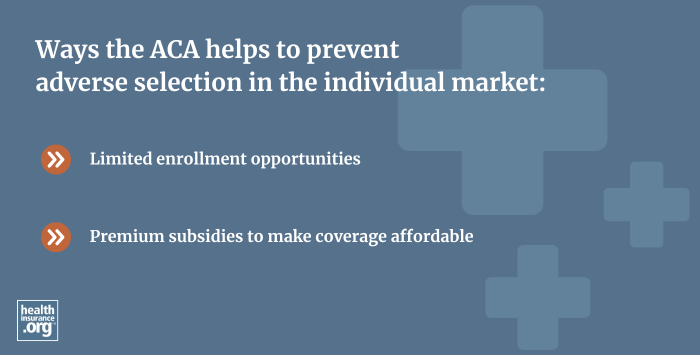
What is adverse selection?
Adverse selection refers to a situation in which the buyers and sellers of an insurance product do not have the same information available. A common example with health insurance occurs when a person waits until they know they are sick and in need of health care before applying for a health insurance policy.
This wasn't an option in the medically underwritten model of individual health insurance (ie, pre-2014 in most states), because pre-existing conditions were a factor in determining eligibility and price.
But since 2014, individual health insurance policies have been guaranteed issue. There was concern that this would lead to adverse selection, with healthy people opting to not purchase health insurance and simply waiting until they needed coverage before enrolling. This would result in adverse selection, which could sharply increase premiums.
Indeed, premiums did increase significantly in the individual market in 2017 and 2018, due in large part to premiums being too low in the early years of ACA implementation, uncertainty about the future of the ACA and enforcement of the individual mandate under the Trump administration, and the Trump administration's decision to cut off CSR funding. But premiums have stabilized significantly since then, with decreases or very small increases in most places from 2019 through 2022, and fairly modest increases since then.1
The ACA's approach to avoiding adverse selection in a guaranteed-issue market is three-fold:
- the law created an individual mandate that imposes a tax penalty if people go without coverage. The penalty was eliminated at the end of 2018 (four states and DC impose their own penalties if people are uninsured) but the other two factors have served to keep premiums stable despite the lack of a federal individual mandate penalty.
- people can only buy coverage during open enrollment or a special enrollment period triggered by a limited number of qualifying life events.
- there are income-based premium tax credits (subsidies) that keep coverage affordable. These tax credits are normally only available to households with income up to 400% of the poverty level, but the American Rescue Plan temporarily eliminated that upper limit, and the Inflation Reduction Act extended that provision through 2025. Subsidies are available regardless of income if the cost of the benchmark plan would otherwise be more than 8.5% of household income. Since the premium tax credits pay the majority of the premiums for most exchange enrollees,2 there's less incentive for healthy people to drop their coverage.
Even still, adverse selection remains a concern, especially in states where regulations or plan availability allow healthy people to buy products such as Farm Bureau health plans or health care sharing ministry coverage.
Some insurers also worry that people are "gaming the system" and qualifying for special enrollment periods when they shouldn't. There was no widespread evidence of SEP fraud, but eligibility verification was stepped up, starting in 2106. The exchanges, including HealthCare.gov have since walked back some of this increased enforcement. HealthCare.gov now only requires proof of a qualifying life event if the event is loss of other coverage, which accounts for the majority of all SEP enrollments.3) But people who plan to enroll during a special enrollment period should still be prepared to provide proof of any qualifying life event, particularly if they're enrolling through a state-run exchange or directly through an insurer (off-exchange).
Enrollment in off-exchange (ACA-compliant) individual/family health insurance has declined over the last several years (off-exchange enrollees have to pay full price for their coverage, as no subsidies are available outside the exchange). But on-exchange enrollment reached another record high in 2024,4 illustrating the power of premium subsidies in keeping adverse selection at bay.
Footnotes
- "Nine Changes to Watch in ACA Open Enrollment 2023" and "How much and why 2024 premiums are expected to grow in Affordable Care Act Marketplaces" and "How Much and Why ACA Marketplace Premiums Are Going Up in 2025" KFF.org. Accessed Oct. 3, 2024 ⤶
- "Effectuated Enrollment: Early 2024 Snapshot and Full Year 2023 Average" CMS.gov, July 2, 2024 ⤶
- "Federally-facilitated Exchange (FFE) Enrollment Manual" CMS.gov. July 12, 2023 ⤶
- "Record Marketplace Coverage in 2024: A Banner Year for Coverage" bidenwhitehouse.archives.gov. Jan. 24, 2024 ⤶
